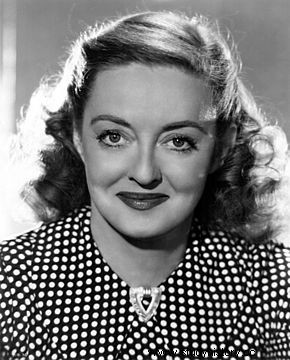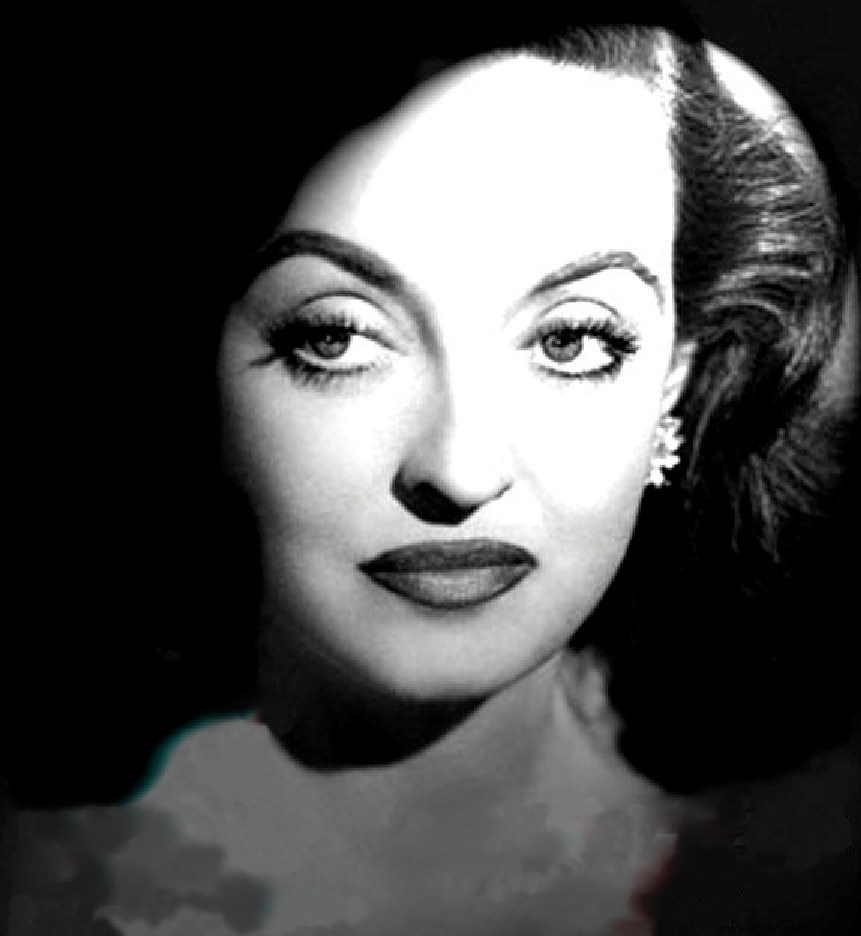Ruth Elizabeth Davis, known as Bette Davis (1908 – 1989) was an American actress. With a career of more than a hundred films, she is renowned for her talent and her roles as strong and tenacious women. She has been nicknamed "Queen of Hollywood", "Queen of Warner Studios" or even "First Lady of the American big screen".
The start of an acting career
 Born April 5, 1908, in Lowell (Massachusetts, United States), Ruth Elizabeth Davis grew up between Massachusetts , New Jersey and New York. Her parents separated when she was seven years old and she and her sister Barbara were raised by their mother, Ruth, a photographer. In her youth, Ruth Elizabeth became Bette, perhaps in reference to the novel "Cousine Bette by Balzac.
Born April 5, 1908, in Lowell (Massachusetts, United States), Ruth Elizabeth Davis grew up between Massachusetts , New Jersey and New York. Her parents separated when she was seven years old and she and her sister Barbara were raised by their mother, Ruth, a photographer. In her youth, Ruth Elizabeth became Bette, perhaps in reference to the novel "Cousine Bette by Balzac.
Bette studied at the Cushing Academy in Ashburnham (Massachusetts) and began acting there with the role of a fairy in A Midsummer Night's Dream of Shakespeare. She then took dance lessons and enrolled at John Murray Anderson's Acting Dramatic School in New York, which she attended for three years. In 1928, she joined a theater troupe, directed by George Cukor, and performed there in several plays including "Broadway and "The Earth Between “, which met with great success. The piece "Broken Dishes marks his first steps on Broadway.
Oscar for best actress
Talented, Bette Davis was quickly noticed by the Universal Pictures film studio, and in 1931 made her first film:The Bad Sister . She shoots two other films with Universal and then lands a few minor roles. As she plans to return to acting, she receives a lead role in The Man Who Played at Being God from actor George Arliss. (1932). After this role, she signed a seven-year contract with Warner Bros. Pictures. The same year, she married Harmon O. Nelson, whom she divorced six years later.
Over the next four years, Bette starred in twenty-five films, including Twenty Thousand Years Under Lockdown and Jimmy the Gent (1935). , two films by Michael Curtiz. In 1934, she insisted on obtaining the role of Mildred Rogers, a cold and manipulative young woman, in The Emprise . Despite her employers telling her that an unsympathetic role would harm her career, she met with great critical success with this film. In 1935, she played a new, unsympathetic role noticed in Frontier Town . In 1936, Bette won her first Oscar for best actress for the role of Joyce Heath, a former adrift theater actress, in The Intruder . Subsequently, the Warner brothers refused him two roles and offered him a few minor films. She then came into conflict with Warner and left Hollywood to shoot two films in London.
Success
 In 1937, Bette Davis made a remarkable comeback in Hollywood by filming with Humphrey Bogart in Scarred Women , where she plays a hostess in a nightclub. From that moment on, Warner offered her films specially written for her, in which she would shoot with Humphrey Bogart, Henry Fonda, Leslie Howard and Olivia de Havilland. She turns down the role of Scarlett O'Hara in Gone with the Wind , because Errol Flynn is imposed on her as a partner and she does not consider him good enough for the role. She then plays in L’Insoumise , written for her, in which she demonstrates her dramatic talent. The film was a huge success and Bette received her second Oscar. Her career took off and she was subsequently nominated many times, notably for the drama Victoire sur la nuit (1939), her role as murderess in The Letter (1940) or as a greedy manipulator in La Vipère (1941). Throughout her career, she played many atypical roles of wounded, vengeful, tenacious, manipulative and even monstrous women.
In 1937, Bette Davis made a remarkable comeback in Hollywood by filming with Humphrey Bogart in Scarred Women , where she plays a hostess in a nightclub. From that moment on, Warner offered her films specially written for her, in which she would shoot with Humphrey Bogart, Henry Fonda, Leslie Howard and Olivia de Havilland. She turns down the role of Scarlett O'Hara in Gone with the Wind , because Errol Flynn is imposed on her as a partner and she does not consider him good enough for the role. She then plays in L’Insoumise , written for her, in which she demonstrates her dramatic talent. The film was a huge success and Bette received her second Oscar. Her career took off and she was subsequently nominated many times, notably for the drama Victoire sur la nuit (1939), her role as murderess in The Letter (1940) or as a greedy manipulator in La Vipère (1941). Throughout her career, she played many atypical roles of wounded, vengeful, tenacious, manipulative and even monstrous women.
Last roles
In 1942, Bette Davis founded and ran Hollywood Canteen , a clib providing entertainment and food to WWII veterans returning from the front. In 1946, she created her own production company, "B.D. Incorporated", which produced a single film:La Voleuse , with Glenn Ford. In 1949, the shooting of the film La Garce goes wrong with the director and Bette gets a release from her contract with Warner Bros. The following year, she obtained the beautiful role of Margo Channing in Eve , a film dealing with theater and competition between artists. Her performance was unanimously acclaimed by critics and she won, among other awards, the Best Actress Award at Cannes. The same year, she married for the fourth time with her partner of Eve, Gary Merrill. They will adopt two children and will divorce in 1960. Thereafter, her career settles a little but she still interprets beautiful roles and her performance in What happened to Baby Jane? (1961) earned him a tenth and final Oscar nomination. She then played in many minors, as well as in theater and television.
Bette Davis died on October 6, 1989 at the American Hospital in Neuilly-sur-Seine, at the age of 81.
